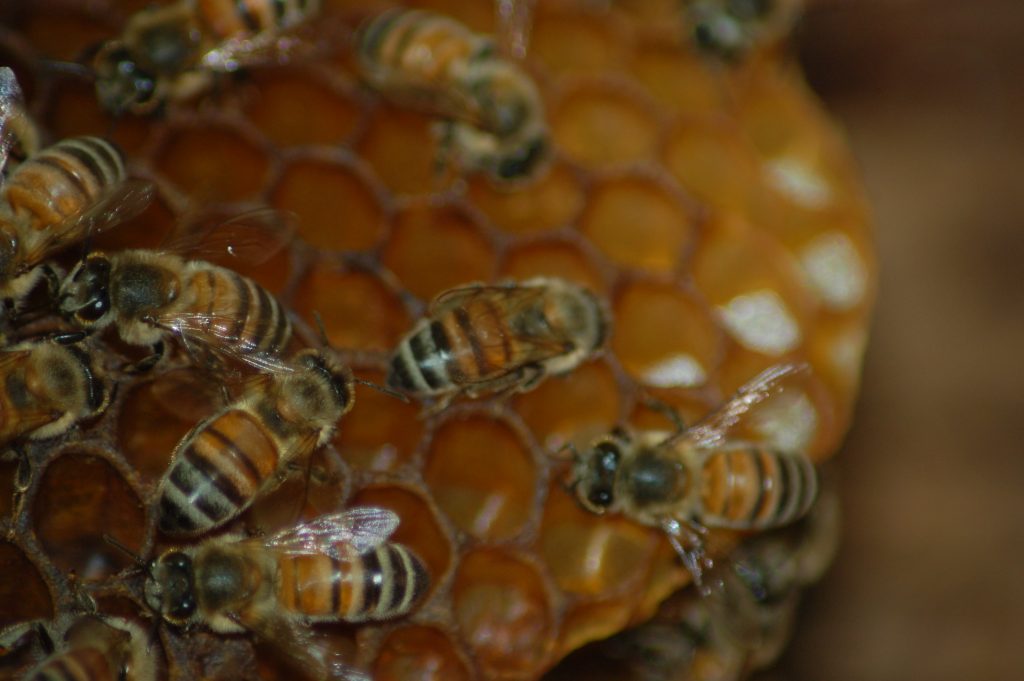Last Updated on February 8, 2023 by
Leaving bees alone when they aren’t bothering you is a good idea because they are essential to our planet’s ecosystem. In contrast, if you see a beehive on or near your property, you need to take action. Check with a beekeeper first to see if they can relocate the hive for you. You can either hire a professional exterminator or destroy the pack yourself if you can’t. If you’re doing the job yourself, wear protective gear, use your insecticide according to the instructions, and remove any remnants of the hive afterward.
Beehive
A beehive is a structure designed to house a colony of honeybees. These unique structures are typically made of a combination of wax and honeycomb, and they provide a safe and sheltered environment for the bees to live, work, and raise their young. Beehives have been used for thousands of years for the production of honey and beeswax, and they play a crucial role in the pollination of plants and flowers.
The interior of the beehive is organized into a series of interconnected chambers that serve different purposes, such as storing honey, raising young, and providing a place for the queen bee to lay eggs. The honeybees within the beehive work together to maintain the hive, gather nectar and pollen, and produce honey. The intricate structure and complex social organization of the beehive make it a fascinating subject of study for scientists and naturalists alike.
Importance of bees
A negative stigma is attached to bees in most people’s homes when they think about them. The first thing that comes to mind is being stung. Everyone dislikes being stung by a bee, so it’s understandable. Nevertheless, bees are essential for the survival of the planet. Our food production system relies heavily on pollination, which is vital.
How to get rid of a beehive?
Method 1: Relocating or eliminating the hive with a professional
Honey bees are the only bees that build beehives, technically speaking. In beehives, waxy material is used (not paper-like material), they’re usually made into openings of existing structures (like a tree or house), and they vary widely in size.
- Different kinds of bees, bumblebees, yellow jackets, and hornets build nests that are not hives, such as wasps, yellow jackets, and hornets.
- Typically, honey bee hives hold between 10,000 and 50,000 bees.
- If you’re not sure what type of bee is stinging you, consult a reliable online guide to determine whether it’s a nest of bees.
If the bees don’t bother you, you can leave the beehive alone.
There is a decline in bee populations for unknown reasons. Let the bees pollinate your flowers if they are not bothering you in the hive, but pollinate them in the garden. Unless they feel threatened, they will not sting.
- In case of allergy to bee venom, you should consult a physician. A bee sting can cause swelling of the lips or throat if you are allergic and can even be fatal in rare cases.
- In addition, if your house is attached to the hive, you should always call an exterminator to remove it. Over time, the expanding multitude can cause significant structural damage to your home, and the bees may work their way into your home.
- In addition to pollinating thousands of kinds of flowering plants, bees pollinate a large portion of the food we eat. It is best to learn to live with bees instead of without them unless you have a good reason.
Relocate a problematic hive with the help of a beekeeper
Local beekeepers sometimes relocate hives to their beekeeping operations for free or a nominal fee as honey bee numbers decline. They probably know a person that provides that service if they don’t.
- Use the phone book or search online. Locate apiaries or beekeepers in your area.
- For information on local beekeepers or wranglers, check local markets or general, stores-especially those that sell local honey.
- Several local farmers’ markets and plant nurseries may be able to help you locate a beekeeper.
If relocation or DIY removal doesn’t work, a professional exterminator should be called.
There may be times when you will have no choice but to relocate the hive yourself. You should only consider exterminating a beehive if you need to remove it. Please do not attempt to handle the job yourself unless you can do it safely.
- It’s not always true that the hive looks small from the outside. It is not uncommon for beehives to extend into trees, walls, chimneys, roofs, etc.
- It can be hazardous to remove a large or complicated hive to reach. You will need a great deal of experience and training to do so.
- Both were hiring a beekeeper and an exterminator involves different costs depending on many factors. You can anticipate paying $100 to $1000 on average.
Method 2: Spraying a hive with insecticide
Ensure that any home repairs and extermination are planned ahead
It would be best to prepare for the entire process before grabbing an insecticide and spraying the beehive. This is essential if your hive is incorporated into or on top of your house. You must:
- When many honeybees are removed from a home, be prepared to do repair work. It may be necessary to cut away walls or structures to access the hive.
- Bee-proof areas where hives and honey cannot be removed (for example, behind stucco and brick) to avoid further infestations.
- Children, pets, and the elderly should be evacuated from the immediate area where a hive is active if they suffer from allergies.
Read More: How To Build A Solar Panel? What Is The Cost Of Solar Panel? And All Other Info
The best time to spray the hive is between late evening and early morning when the bees are asleep (and in the pack). A beehive is most easily removed in late winter or early spring depending on the season. Beehive populations are at their lowest during this time. All the bees will likely be at the hive at night since they are less active at night. The difficulty of killing bees at night is that they are harder to see. Spraying at night can be done with a flashlight covered in red cellophane. Bees cannot see red light.
Be sure you are wearing protective gear, such as long sleeves, gloves, and a bee veil
Wear appropriate clothing to exterminate a beehive. In the process of removing beehives, clothing plays a significant role. Wearing light color and smooth clothing is the best way to remove bees. Bees are more likely to become agitated by dark colors and rough clothing. Dress in heavyweight clothing covering your arms and legs. If you require a white beekeeper’s suit, you might want to invest in one.
- A jumpsuit pattern and ripstop nylon material can make a homemade bee suit.
- Wear gloves that offer considerable protection for your hands. When removing beehives, professionals mostly wear leather gloves.
- Professional beekeepers wear beekeeper’s veil, which provides excellent protection without hindering vision. Purchase one at a farming supply store or online.
- Avoid wearing heavy scents such as perfume, cologne, or scented deodorant. These scents may fool bees into thinking that you are flowering.
Use an insecticide designed to kill bees.
If you want to eliminate beehives yourself, you can use a commercial insecticide rather than a homemade recipe online. You can purchase an insecticide spray with bees on the label at a home center. If you prefer dusting powder over-spraying, you can buy insecticide dusting powder. Regardless of the application method, the result will be the same.
It is usually easy to locate the central entry hole of every beehive. When you imagine the entire hive interior is saturated, hold the spray can up next to the opening and spray for a few seconds. Inject the insecticide dust into the hive through the tip of the applicator if you are using a cloud of an insecticide dust. The insecticide should be sprayed all over the outside of the pack if you can’t locate or reach the central entry hole. There will probably need to be several more spraying applications over several days for this to work.
FAQs
- Is there a natural way to remove a beehive?
In a spray bottle, combine vinegar and water in equal amounts. Be careful of agitated bees and wear protective clothing while spraying the mixture on the nest at night.
- Do bees die instantly if they are agitated?
The vinegar kills bees almost instantly, as they cannot handle it. If you have a few bees in your home, mix vinegar and water to get rid of them.
- Am I able to remove beehives myself?
If you don’t have a problem with the bees, don’t disturb the beehive. Only when they feel threatened will they sting. Nonetheless, if you’re allergic to bee venom, you should always consult a physician.

